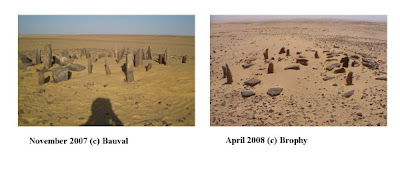Neo-Barbarians at Nabta Playa, Egypt
About one hundred miles west of Aswan in the Sahara Desert lay an archaeological site called Nabta Playa. Only ten to eleven feet in diameter, this megalithic calendar circle has a north/south line-of-sight as well as a summer solstice sunrise alignment. According to former NASA physicist Thomas G. Brophy, Ph.D., three stones inside the circle mirror the pattern of Orion’s belt at the meridian for this season during the period 6400 to 4900 B.C. Three other interior stones represent the shoulders and head of the constellation for the astoundingly early date of 16,500 B.C.
Another set of megaliths south of the circle align to the vernal equinox heliacal rising in 6300 B.C. of six of key stars of Orion: Alnitak, Alnilam, Mintaka (the belt), Betelgeuse, Bellatrix (the shoulders), and Meissa (the head). This vernal equinox heliacal rising happens only once per precessional cycle (25,920 years).
Even more astonishing is the fact that some of these megaliths are arranged proportionally to correspond to the physical distance from Earth of each of the aforementioned stars except Meissa. In addition, other megaliths in this group are arranged proportionally to correspond to the same stars’ radial velocity, or the speeds at which these stars are moving away from us.
“The companion megaliths in each distance alignment match corresponding megaliths in each velocity alignment in such a way as to fit the physics of orbital motion, and thus probably represent actual companion objects to the six primary stars. Meaning: The designers of the megaliths had a basic understanding of physics, and knowledge of astronomy that rivaled or surpassed ours today.” [Thomas G. Brophy, Ph.D., The Origin Map: Discovery of a Prehistoric, Megalithic Astrophysical Map and Sculpture of the Universe, Writers Club Press/iUniverse, New York/Lincoln, Nebraska, 2002, p. 104]
Compounding the complexity of this astrophysical map, a sculpture carved into the bedrock has been found buried beneath the surface sediment. This sculpture accurately depicts the Milky Way Galaxy, showing the relationship between our Sun and the vernal equinox heliacal rising of the Galactic Center circa 17,400 B.C. Given the astronomical encoding of this site, Nabta Playa’s homage to Orion reveals an understanding of the cosmos that shatters our traditional notions of the ancient world.
Considering the site’s astounding data that do not seem to fit any traditional paradigm of a “primitive” culture, it was heartbreaking to learn about the recent vandalism of such an important archaeological treasure. Robert Bauval posted the following on April 23, 2008 at the Graham Hancock Message Board:
“Thomas Brophy has just returned from a visit to Napta Playa. Yesterday in Cairo we compared photographs of the 'Calendar Circle' taken by myself in November 2007 and by Thomas Brophy a few days ago. We were shocked at the apparent 'vandalisation' of the site (see photo).

"Brophy had visited the site also back in 2003 and took extensive photography. During his visit last week he noted that some of the most beautifully worked stone in the Calendar Circle were missing, and that many of the standing stones had been knocked down, moved around and even broken. Also Brophy noted that a carved megalith at Complex Structure A was also missing. Evidence of a recent encampment --in the form of rubbish-- was found nearby (see photo). It would also seem that some of the beautifully worked grinding blocks and stones were also missing.

"In all occasions that either Brophy or myself had visited the site (10/2003,11/2007 and 4/2008), we were both extremely surprised that the area was totally unsupervised and that absolutely no security was in place, not even a panel informing visitors that this was an important prehistoric site still under study and asking them not to touch or remove any of the stones. Considering that Napta Playa was discovered in 1974 and, since 1998, has been declared the oldest and thus most important astronomical site in the world, this total lack of supervision and/or security is, to say the least, deplorable.
"Thomas Brophy and myself will be reporting this grave matter to the Egyptian authorities in the hope that they will take the long-overdue action that is needed to safeguard the site. To place a security officer at Napta Playa would only cost a few hundred dollars per month. We really cannot comprehend why such an important prehistoric site has been, and still is, left totally unattended and thus at the mercy of any vandals. Its proximity to Abu Simbel (100 km) makes Napta Playa extremely vulnerable to such vandalism and souvenir seekers.”
www.grahamhancock.com/phorum/read.php?f=1&i=240359&t=240359
Because of its current damaged state, we probably will never learn who constructed Nabta Playa, much less how such knowledge in prehistoric times was programmed into its megaliths. Sic transit gloria aborigine.

